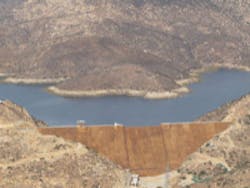WaterWorld Weekly Newscast, March 27, 2017
The following is a transcript of the WaterWorld Weekly Newscast for March 27, 2017.
Hi, I'm Angela Godwin for WaterWorld magazine, bringing you water and wastewater news headlines for the week of March 27. Coming up...
Water professionals experience innovation through exchange scholarship program
San Diego water supply reliability project wins prestigious engineering award
Water reuse efforts at Intel recognized by GE
Wastewater pollution results in record fine for Thames Water
A scholarship program organized by the Leaders Innovation Forum for Technology (LIFT) is enabling staff from water resource recovery facilities to learn about innovations at other utilities.
This year, 32 staff from 11 water resource recovery facilities across the country have received travel scholarships through the Scholarship Exchange Experience for Innovation & Technology (or SEE IT) program.
Recipients will travel to other utilities across the country and abroad to gain new perspectives that support the transformation of water resource recovery facilities into utilities of the future.
The scholarship program, launched in 2016, is a joint initiative spearheaded by Water Environment & Reuse Foundation, the Water Environment Federation, and the National Association of Clean Water Agencies.
Applications for 2018 LIFT SEE IT scholarships opens in the fall.
For more information, visit werf.org/LIFT
The San Diego County Water Authority’s $1.5 billion Emergency & Carryover Storage Project, built to protect the region from droughts and catastrophic disruptions to imported water supplies, has won the Outstanding Civil Engineering Achievement Award from the American Society of Civil Engineers.
The Emergency & Carryover Storage Project, begun in 1992, comprises several large dams, reservoirs, pump stations, pipelines and tunnels.
The system is designed to ensure up to six months of local supplies are available and can be moved around the region after an emergency, such as an earthquake.
The project also added 100,000 acre-feet of local “carryover” storage -- water stored during wet years to help meet demands in dry years.
Overall it is one of the nation’s largest and most innovative infrastructure improvement projects, adding 196,000 acre-feet of locally available water storage.
In industrial water news, GE has honored Intel Corporation with an Ecomagination Award to celebrate a new water recycling project at Intel’s Ronler Acres campus in Hillsboro, Oregon.
Once operational, the facility will recycle industrial water discharged from the manufacturing process for reuse in facility systems such as cooling towers, scrubbers and abatement equipment.
In addition, the water discharged to the municipal wastewater treatment system will be cooler and cleaner.
When complete, the facility will have the potential to recycle over a billion gallons of water annually.
GE’s Ecomagination Award recognizes the achievements of its global industrial users and top GE customers that implement innovative solutions driving business value and environmental benefit.
In international news, UK water utility giant Thames Water has been fined an unprecedented US$25 million for a series of sewage discharge incidents on the River Thames.
UK regulator the Environment Agency (EA) brought charges in six cases that together caused widespread pollution and environmental damage at a number of sites from 2012 to 2014.
According to EA, with an estimated volume of 370,000 gallons, the illegal sewage discharges comprised the “biggest freshwater pollution case” in its 20-year history.
Thames Water's Richard Aylard acknowledged the utility's failures and said that "lessons have been learned."
He also said the fine would be paid by shareholders, not by raising customers' rates.
For WaterWorld magazine, I'm Angela Godwin. Thanks for watching.
